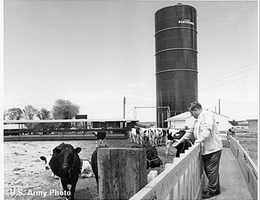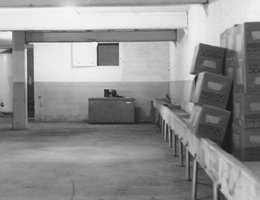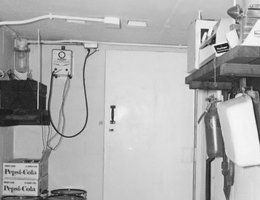

Human beings weren’t the only species selected to survive a nuclear attack in Nebraska. In 1963, Roberts Dairy Company, outside of Omaha, conducted a two-week survival test for 35 cows, one bull, and two student cowhands. They built a concrete shelter under the dairy at Elkhorn that was big enough to house over 200 Golden Guernsey cows and a couple of bulls. Milk is especially susceptible to contamination by radioactive elements, and so Roberts and the Office of Civil Defense wanted to see if they could protect the cows and still produce milk.

A special storage space was created for cattle feed, and water for the occupants of the shelter came from a 10,000 gallon tank buried under five feet of dirt next to a shelter wall. An auxiliary generator was available if electrical power was interrupted by an atomic blast. Five fans provided ventilation. The air was cleaned by a series of dust filters.
The shelter was built at a cost of $35,000, and included living quarters for employees who were to care for the herd. This shelter was separated from the cow shelter and was stocked with supplies for 15 people. It had a separate fan that brought in fresh, filtered air and kept possible offensive odors from the cattle out of the room. There were also bunks near the cows.
Two students, Dennis DeFrain and "Ike" Anderson, were involved in the experiment and reported that they missed cold foods, and especially missed cold milk. Otherwise, they and the cows were fine. They had a two-way radio loaned to them by the Omaha Civil Defense Office that enabled them to communicate with the outside world. Dairy President, J. Gordon Roberts, heard about their concerns and at the conclusion of the testing, met them at the door with a large pitcher of cold milk, paper cups, and a supply of sweet rolls.
The men also complained about boredom and the monotonous food. They felt regular meals should be planned to differentiate morning from evening and reduce the problems they faced of keeping track of time. They did admit that boredom was reduced by the fact they had specific duties to perform, such as feeding the cattle.

The problems with keeping track of normal day-night rhythms was a part of the experiment. Electric lights in the shelter were used to reverse the biological clocks of the cattle and reduce the amount of heat and humidity present. Lights were turned off during the hottest part of the day outside to reduce cattle activity. Then during the cooler part of the day, they were turned on to permit the cattle to feed, drink, and move around their confined quarters.
Noise seemed to become a factor toward the end of men’s stay. This may have suggested that they experienced some irritability and anxiousness for the experiment to end.
The two young men were asked after the completion of the project if they would go through another shelter test later on. Their response was "Well, we don’t want to look at another cow for a couple of weeks."
The cows and one lone bull (named Aristocrat) showed little signs of discomfort after their confinement. They lost a little weight, but adjusted quickly to the topsy-turvy life underground.
The organizers of the shelter were convinced that the test showed cattle could live in a shelter and continue to produce. They proved that such protected existence was feasible, and could prove to be economically sound, even in peacetime, as a way of housing dairy cattle.
President J. Gordon Roberts said, "In a Democracy, the citizens ultimately determine what foreign policy should be. If we have our people prepared for the worst, and tests like this one can contribute a great deal to that preparedness, then both Russia and China must think twice about using atomic weapons on our country."